The cardinal climber certainly is a beautiful plant, especially when it is in full bloom. Its scientific name is Ipomoea × multifida, but I will be referring to it by its more common names for the purpose of this article.
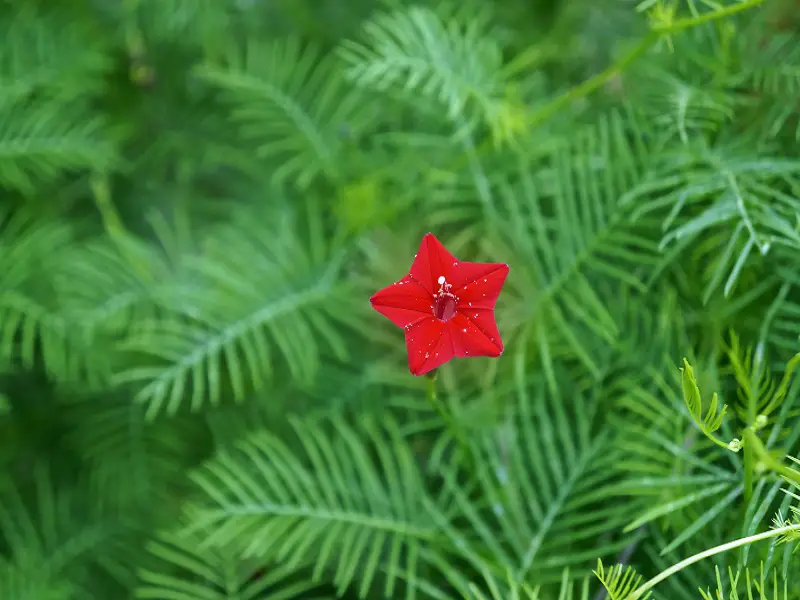
| Scientific Name | Ipomoea × multifida |
| Common Names | Cardinal climber, cypress vine, cypress vine morning glory, cardinal creeper, cardinal vine, star glory, star of Bethlehem, or hummingbird vine |
| Hardiness | True annual |
| Indoor or Outdoor Plant? | Outdoor plant |
| Sun Exposure | Full sun |
| Water | One inch of water each week |
| Size | Up to eight feet fall |
| Soil Type | Well-drained soil |
| Soil pH | Neutral pH between 6 and 7.2 |
| Flower | Bright red flowers |
| Growing Difficulty Level | Easy |
Cardinal Climber Appearance and Characteristics
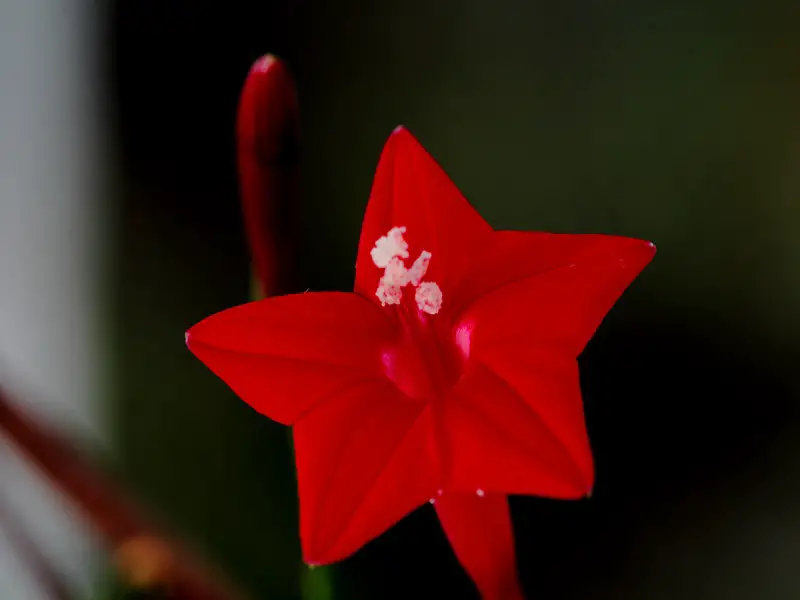
The cardinal climber is a very delicate-looking plant. It has thin stems and slender leaves with bright red flowers.
The flowers are star-shaped, and the flower petals are all connected. The throat of the flower is yellow and white, although plants vary in tones due to the variations between parent plants.
Cardinal Climber Plant Growing Advantages
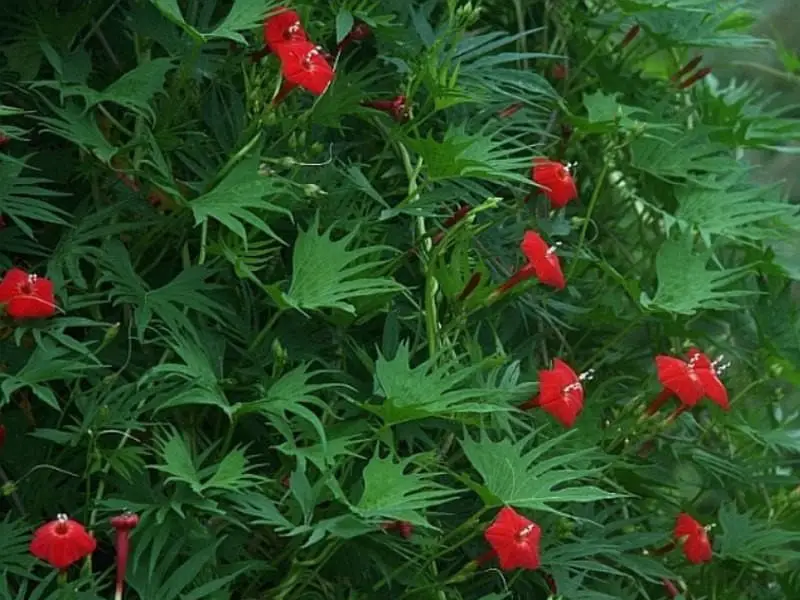
If you are particularly concerned with interpolation between plants. In that case, a huge advantage of growing cardinal climbers is that you can pair them with morning glory and cypress plants without that occurring.
This is particularly important for plant growers who want their plant’s characteristics to remain true to the species.
This also isn’t an invasive plant.
The seeds go sterile during frost, so you won’t find yourself battling with mother nature trying to control a colony of cardinal climbers.
Garden landscapers love this plant because it is so easy to control and maintain.
Cardinal Climber Growing Guide
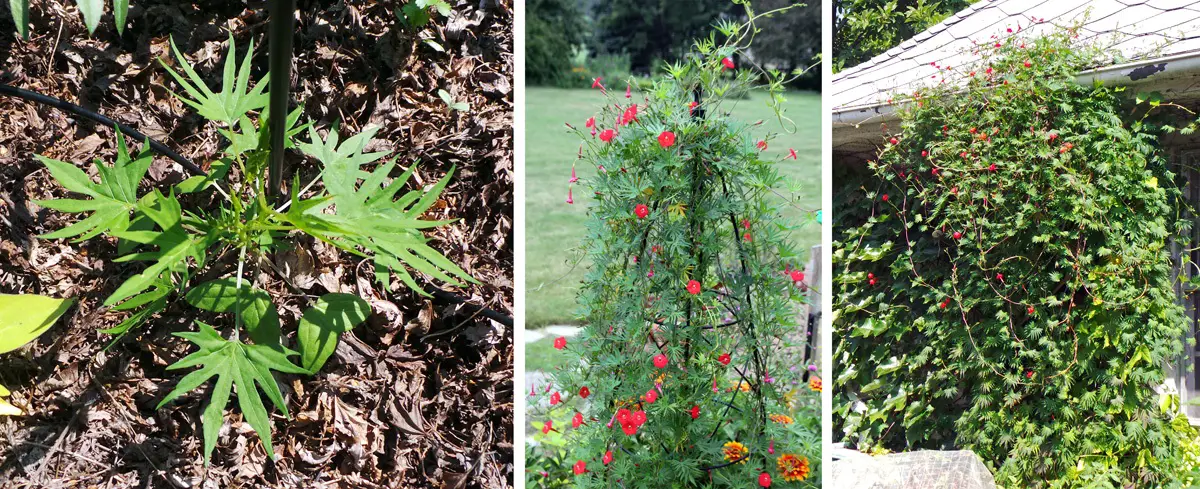
Growing cardinal climbers is so easy that most beginner gardeners manage to do so without any hassle or breaking a sweat.
Use the following growing guide information to help you grow these bright and delicate plants with success.
Water
Make sure you water the plant regularly.
I recommend regularly checking the soil’s moisture levels by poking your fingers into the top two inches of soil to assess the plant’s water needs.
It is important that you don’t drown the plant in water as it can flood the roots and cause root rot or other problems—instead, only water the plant when the first inch of soil is dry.
Light
The more natural sunlight this plant gets, the better! You want to keep this plant in full sunlight for the majority of the year; however, it will tolerate growing in partial shade.
Sunlight shouldn’t be an issue as most cardinal climber growers choose to pot these plants outside.
Soil
Keeping the pH levels of the soil neutral is the most difficult part of caring for this plant. In order to do this, you may prefer to purchase fertilizer-free potting soil with good drainage.
You can use the soil in your backyard if you like, but you will need to test its pH levels regularly and use neutralizers to keep the pH levels at an ideal level.
If the soil in your yard is poor, then you can use an organic fertilizer to give it a boost.
Temperature and Humidity
Cardinal climber plants will grow well in hot and cold temperatures.
Hot weather prompts faster growth, but your plant will grow slowly and steadily during the cooler winter months.
Another thing this plant loves is humidity, so if you live in a humid area such as Florida, then your cardinal climber will thrive.
You will need to think of ways to protect your plant from extreme cold and winter frost, as this may cause your plant to wilt and shrivel.
Potting and Repotting
The great thing about cardinal climbers is that you can plant them directly into the soil, in garden containers, or in individual pots.
If you plan on planting your plant into a pot, make sure it has sufficient drainage holes to stop excess water from drawing its roots.
Plastic pots are not ideal as they keep a lot of water trapped in the pot.
Terracotta and clay pots are better as they not only have drainage holes at the bottom of the pot but they absorb excess water into the pot itself.
Propagating and Pruning
This hybrid plant should be grown from seeds.
If your plant has produced many seeds in the summer, you can try to replant the dried seed pod the following summer; however, this doesn’t have a high success rate.
As for pruning the plant, you will only need to do some very simple maintenance as its natural bush-like features look the best as they are.
Remove dead or wilting flowers, remove diseased or damaged parts of the plant as and when you need to, and thin out thick stems to keep the plant looking aesthetic.
Top Tip: Do a weekly visual check for any signs of damage and trim accordingly. Make sure not to overdo it, as this plant can look sparse very quickly.
Cardinal Climber Pests, Diseases, and Problems
Cardinal climbers that are particularly healthy and succulent may attract whiteflies in the warmer months.
Performing a physical check and looking out for the flies themselves or for signs of damage is the best way to identify if the plant is infested.
Whiteflies are very small and bright white, so they won’t be hard to spot against the green stems and leaves.
These don’t actually fly, and they are more closely related to aphids than flies.
You can treat a whitefly infestation with an insecticidal soap that can be purchased at your local garden center.
Cardinal Climber Seeds and Growing from Seedlings
If you are lucky enough to get your hands on some high-quality cardinal climber seeds, then growing them from seedlings is very easy indeed.
Sow the seeds into the soil in the spring once the last of the frost has passed.
You can also start the seedlings off indoors in a more controlled environment if you feel more comfortable doing that.
Plant the seeds ¼ inches into the soil and water the soil daily until you see signs of growth.
Soaking the seeds overnight before planting them encourages germination, and healthy seeds will germinate within 14 days of being planted.


FAQs
How long does it take cardinal climbers to bloom?
Cardinal climbers will bloom from summer right through to frost. This long flowering time makes them highly desired by budding gardeners and flower lovers.
How long does it take a cardinal climber to fully mature?
Cardinal climbers reach full maturity after about 70 days; however, it usually takes the plants about 90 days to become fully developed and mature if they were grown from seedlings.
How close should I plant cardinal climbers from one another?
Make sure that you leave a minimum of 10 inches between cardinal climbers so that they have enough room to grow freely.
Cardinal climbers may be fairly slight plants; they flow in the wind and may damage one another if they are planted too closely.
Should I prune cardinal climbers regularly?
No, you should avoid over-pruning your cardinal climber to prevent it from looking sparse and sad.
The only maintenance you will need to do is to make sure the plant is free of pests and diseases and remove dead or damaged parts of the plant when you see them.
How much sunlight do cardinal climbers need?
Cardinal climbers will need to be kept in an area of the garden that gets at least five to seven hours of direct sunlight.
You can also keep the plants in partial shade; however, they will not grow as fast as plants that get longer hours in the sun.
Are cardinal climbers poisonous to cats or dogs?
Yes, these plants are toxic to cats, dogs, and even humans. If your pet ingests this plant, it will suffer from an upset stomach and may develop a rash.
You should take your pet to get medical attention if you fear they have eaten part of your cardinal climber.
How long will it take cardinal climber seeds to germinate?
Cardinal climber seeds will germinate within 21 days of planting.
Most seeds will germinate between 10 to 14 days, but do not get disheartened if your seeds take a little longer.
How did you get on growing cardinal climbers in your backyard? How did you landscape them? Let us know! Please share your tips, tricks, and suggestions in the comments section below!


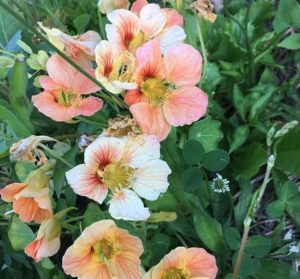
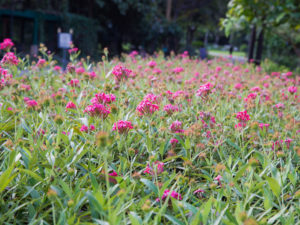

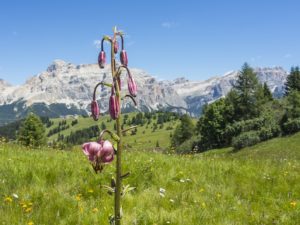
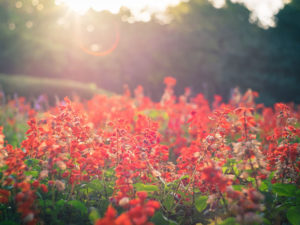

I’m needing to learn if the cypress vine is toxic to domestic sheep.
Sheep are very sensitive to many common plants, so I want solid information before deciding to plant this variety of plants.
Thank You.
My first awareness of the cardinal climber was from an envelope of mixed annual seeds. I was surprised at the cypress looking greenery and then when the bright red uniquely shaped red flowers appeared, I was sold on this annual. I have planted my saved seeds every year!